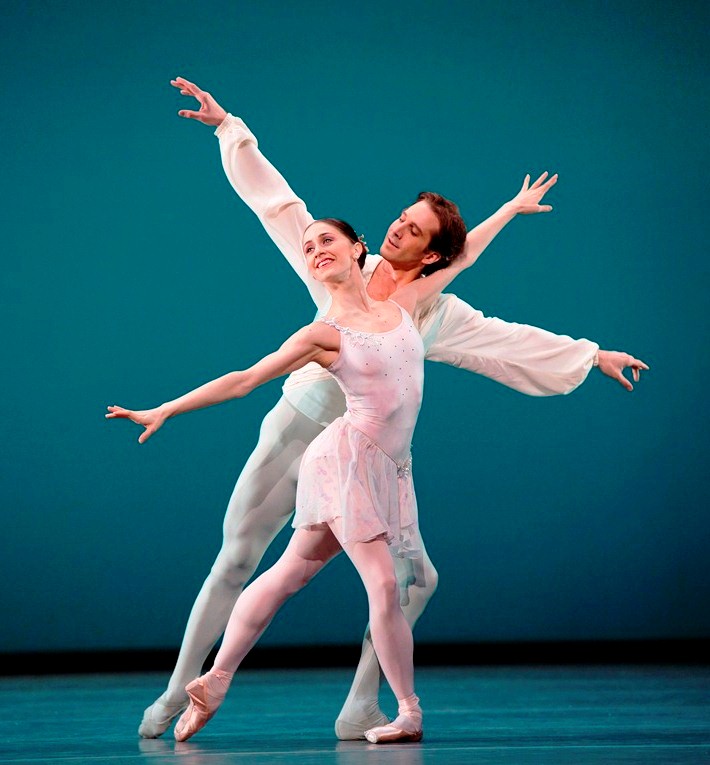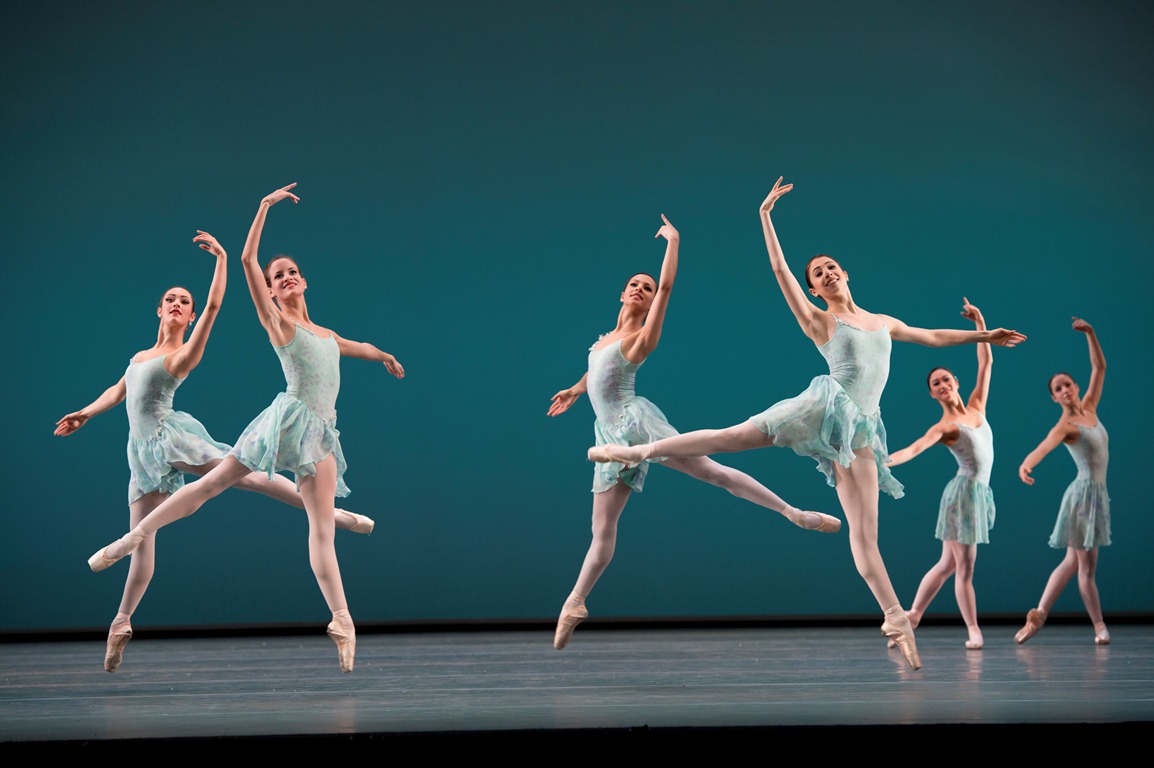Ballo della Regina/ La Sylphide, Royal Ballet | reviews, news & interviews
Ballo della Regina/ La Sylphide, Royal Ballet
Ballo della Regina/ La Sylphide, Royal Ballet
Sylph meets Scot. And magic happens
Ballo della Regina is a strange piece, for many reasons. A piece of minor Balanchine, it was created late in life for a dancer he clearly admired but who was not core to his vision. Strangest of all, he used music by Verdi, a composer whose music he had only choreographed to in his very early days as a journeyman opera-house ballet-master, when he did not get to choose.
 So what does the piece tell us? Very little, really. Staged by Merrill Ashley, its original lead, it is efficient, neat, well-rehearsed. And I can see no real purpose to it. The curtain rises on a heart-liftingly familiar Balanchine opening, turquoise scrim, a corps of 12 women strung out like beads across the stage (pictured overleaf). They are joined by four soloists (Yuhui Choe and Beatriz Stix-Brunell dancing particularly beautifully), and then by the lead couple, Marianela Nuñez and Nehemiah Kish (pictured right, photo: Bill Cooper).
So what does the piece tell us? Very little, really. Staged by Merrill Ashley, its original lead, it is efficient, neat, well-rehearsed. And I can see no real purpose to it. The curtain rises on a heart-liftingly familiar Balanchine opening, turquoise scrim, a corps of 12 women strung out like beads across the stage (pictured overleaf). They are joined by four soloists (Yuhui Choe and Beatriz Stix-Brunell dancing particularly beautifully), and then by the lead couple, Marianela Nuñez and Nehemiah Kish (pictured right, photo: Bill Cooper).
Nuñez performs technical feats of bravura skill in her fiendishly difficult steps (there seems to be barely a second when she is off point, and she is usually required to jump from and to point as well). Kish is not particularly well suited as her partner, or to this role: he is far too tall, and his extremely long torso makes him look awkward even when his steps are neat and clean; in his jumps his arms wave distractingly, and he seems uncentred even when he is not.
But it is the piece itself where the trouble lies. It has no real impetus, no forward motion driven by the music. A ballet number from the opera Don Carlos, it stops and starts in for a drama that no longer takes place; it rises to a climax, hails a procession that does not materialise; the brass bombast must sound wonderful accompanied by opera staging, but when wisps of dancers skim the stage, it seems foolishly overblown. All credit, therefore, to everyone on stage for making the action seem more purposeful than it is.
 With La Sylphide there can be no such questions of purpose. This is a revival of Johan Kobborg’s staging of August Bournonville’s early 19th-century classic of the Romantic repertoire. Alina Cojocaru could not be more perfectly cast than the sylph that slides into a prosaic Scottish farmhouse and lures the soon-to-be-married James (Steven McRae) away from his fiancée Effie (Emma Maguire) and to the forest glen where, of course, he meets an unhappy end.
With La Sylphide there can be no such questions of purpose. This is a revival of Johan Kobborg’s staging of August Bournonville’s early 19th-century classic of the Romantic repertoire. Alina Cojocaru could not be more perfectly cast than the sylph that slides into a prosaic Scottish farmhouse and lures the soon-to-be-married James (Steven McRae) away from his fiancée Effie (Emma Maguire) and to the forest glen where, of course, he meets an unhappy end.
Cojocaru is a dancer of richness. Here her acting skills make the mysterious sylph live. Does she want James because she is in love with him? Or because she wants to torment him? To spite Effie? Is she driven to it by something greater than herself? With Cojocaru it is all of these things, and they change, from minute to minute. Now she is alluring, now she is a puppy begging her new-found friend to come and play, now she is a tantalising scent on the breeze, barely visible at all. In her dancing, the accents, speeding up, slowing down, never come where one expects. Yet they are not perversely chosen, but always driven by the music first, and then the drama.
A very very impressive performance indeed from this young soloist
James’ is a less sympathetic role: he has, after all, dumped his girl to chase out into the woods. McRae makes his longing for something more than he has, something he can’t define, understandable, and even (almost) commendable. His dancing, too, is fine: wonderful clean Bournonville jumps, crisp, clear, clean footwork, good height. Valentino Zucchetti, who plays Gurn, the farmer who will step in and marry the spurned Effie, is his equal here: a very very impressive performance indeed from this young soloist, and his jumps are formidable.
Kobborg has ensured that the details are meticulously observed. Kristen McNally’s Madge, the crone – is she a witch? We never really know – who wants revenge on James and foretells his doom is particularly enjoyable, especially the genteel refinement she uses in wiping the corner of her mouth after sinking a couple of glasses of schnapps.
Watch Alina Cojocaru and Johan Kobborg in an extract from Bournonville's Flower Festival at Genzano
Add comment
more Dance
 MacMillan Celebrated, Royal Ballet review - out of mothballs, three vintage works to marvel at
Less-known pieces spanning the career of a great choreographer underline his greatness
MacMillan Celebrated, Royal Ballet review - out of mothballs, three vintage works to marvel at
Less-known pieces spanning the career of a great choreographer underline his greatness
 Carmen, English National Ballet review - lots of energy, even violence, but nothing new to say
Johan Inger's take on Carmen tries but fails to make a point about male violence
Carmen, English National Ballet review - lots of energy, even violence, but nothing new to say
Johan Inger's take on Carmen tries but fails to make a point about male violence
 WAKE, National Stadium, Dublin review - a rainbow river of dance, song, and so much else
THISISPOPBABY serves up a joyous tapestry of Ireland contemporary and traditional
WAKE, National Stadium, Dublin review - a rainbow river of dance, song, and so much else
THISISPOPBABY serves up a joyous tapestry of Ireland contemporary and traditional
 Swan Lake, Royal Ballet review - grand, eloquent, superb
Liam Scarlett's fine refashioning returns for a third season, and looks better than ever
Swan Lake, Royal Ballet review - grand, eloquent, superb
Liam Scarlett's fine refashioning returns for a third season, and looks better than ever
 First Person: Ten Years On - Flamenco guitarist Paco Peña pays tribute to his friend, the late, great Paco de Lucía
On the 10th anniversary of his death, memories of the prodigious musician who broadened the reach of flamenco into jazz and beyond
First Person: Ten Years On - Flamenco guitarist Paco Peña pays tribute to his friend, the late, great Paco de Lucía
On the 10th anniversary of his death, memories of the prodigious musician who broadened the reach of flamenco into jazz and beyond
 Dance for Ukraine Gala, London Palladium review - a second rich helping of international dancers
Ivan Putrov's latest gala was a satisfying mix of stars and young hopefuls
Dance for Ukraine Gala, London Palladium review - a second rich helping of international dancers
Ivan Putrov's latest gala was a satisfying mix of stars and young hopefuls
 Nelken: A Piece by Pina Bausch, Sadler's Wells review - welcome return for an indelible classic
A new generation of gifted performers for us to get to know
Nelken: A Piece by Pina Bausch, Sadler's Wells review - welcome return for an indelible classic
A new generation of gifted performers for us to get to know
 Dark With Excessive Bright, Royal Ballet review - a close encounter with dancers stripped bare
The Royal's Festival of New Choreography launches with an unforgettable walk in the dark
Dark With Excessive Bright, Royal Ballet review - a close encounter with dancers stripped bare
The Royal's Festival of New Choreography launches with an unforgettable walk in the dark
 La Strada, Sadler's Wells review - a long and bumpy road
Even the exceptional talents of Alina Cojocaru can't save dance adaptation of Fellini film
La Strada, Sadler's Wells review - a long and bumpy road
Even the exceptional talents of Alina Cojocaru can't save dance adaptation of Fellini film
 First Person: pioneering juggler Sean Gandini reflects on how the spirit of Pina Bausch has infiltrated his work
As Tanztheater Wuppertal Pina Bausch's 'Nelken' comes to Sadler’s Wells, a tribute from across the art forms
First Person: pioneering juggler Sean Gandini reflects on how the spirit of Pina Bausch has infiltrated his work
As Tanztheater Wuppertal Pina Bausch's 'Nelken' comes to Sadler’s Wells, a tribute from across the art forms
 Manon, Royal Ballet review - a glorious half-century revival of a modern classic
Fifty years on, Kenneth MacMillan's crash-and-burn anti-heroine is riding high
Manon, Royal Ballet review - a glorious half-century revival of a modern classic
Fifty years on, Kenneth MacMillan's crash-and-burn anti-heroine is riding high
 Giselle, English National Ballet, Coliseum review - if you go down to the woods today, beware of the Wilis
A revival of Mary Skeaping's lovingly researched production, packed with lively detail and terrific suspense
Giselle, English National Ballet, Coliseum review - if you go down to the woods today, beware of the Wilis
A revival of Mary Skeaping's lovingly researched production, packed with lively detail and terrific suspense

Comments
Oh Judith, wake up. For a
The great Arlene Croce has
Cojocaru never fails to